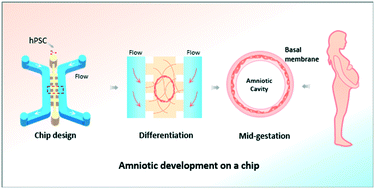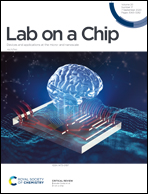Amnion-on-a-chip: modeling human amniotic development in mid-gestation from pluripotent stem cells†
Abstract
The amnion serves to create a protective environment for a growing fetus, and the study of amniotic development will greatly facilitate our understanding of normal and abnormal pregnancies. However, this remains a poorly studied field due to the lack of ideal human models. Herein, we present an integrative strategy to generate amnion-like cavity tissue from human pluripotent stem cells (hPSCs) in an amnion-on-a-chip device through combining a bioengineering approach and developmental biology principles. hPSCs could self-organize into an amnion epithelial cavity in a perfusable 3D culture microchip, resembling human amniotic development in mid-gestation. These cavities exhibited the critical features of amnion tissue based on morphological characteristics, marker expression, and transcriptome analysis. RNA-seq revealed that a set of amnion-specific genes were highly expressed in the obtained cavities, suggesting that the amnion epithelium was derived from hPSCs. Moreover, the amnion-specific mid-gestation marker KRT24 was highly expressed at the mRNA and protein levels, verifying the high maturation of amnion tissues after long-term 3D culturing and differentiation for up to 20 days. These new findings demonstrate the potential of this new amnion-on-a-chip model for investigating essential biological events in human amnions in normal and diseased states via integrating microengineering technology and stem cell biology.



 Please wait while we load your content...
Please wait while we load your content...